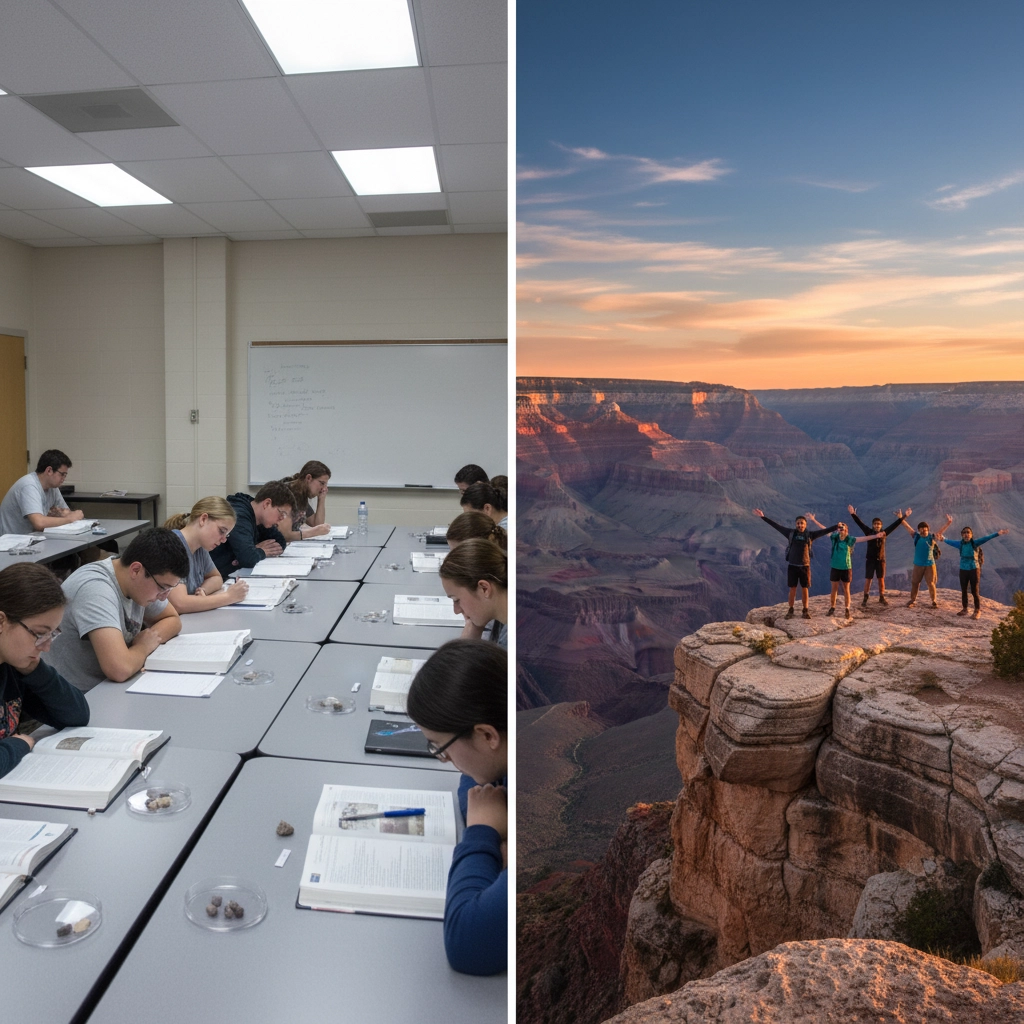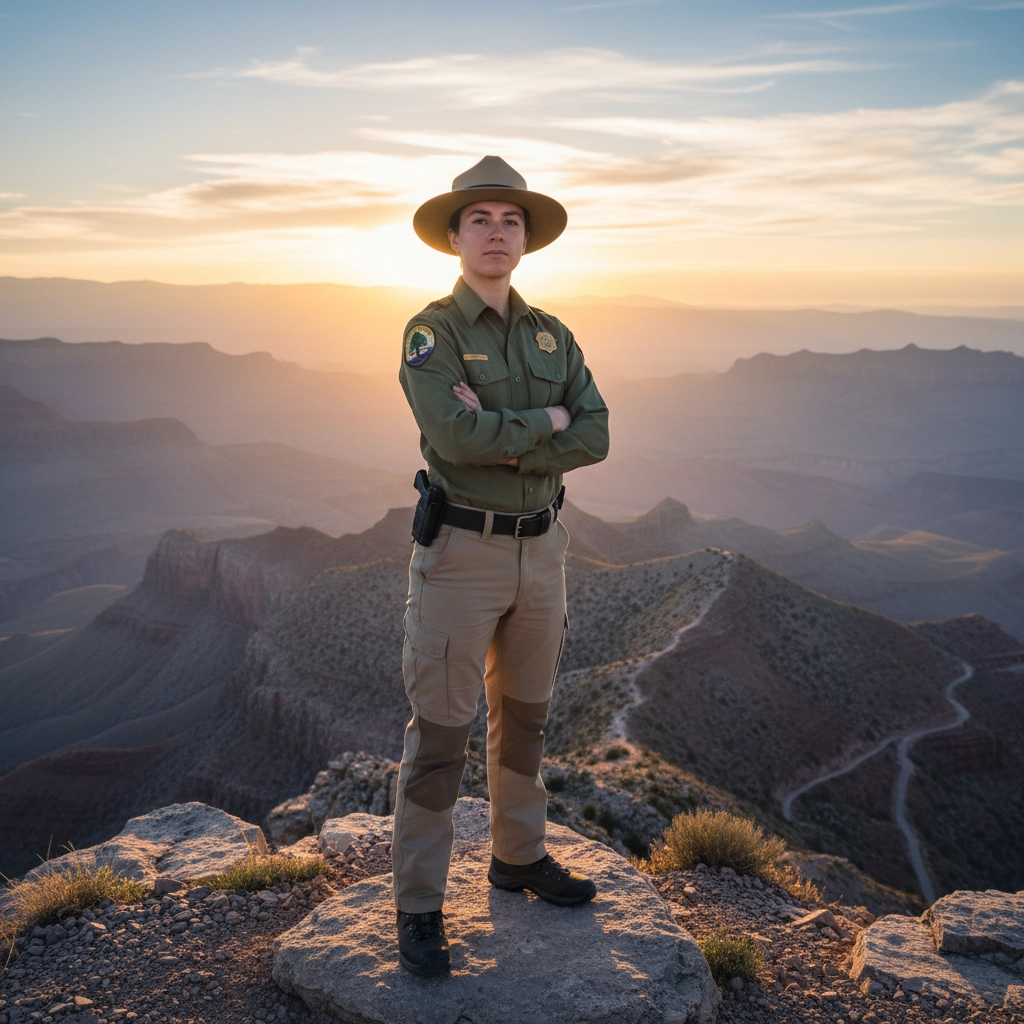Grand Canyon Geology vs. Classroom Learning: Which Creates More Lasting Impact for Students?
- Caleb Mullenix
- 1 hour ago
- 6 min read
Ensuring students develop a deep understanding of geological processes and earth science concepts is of paramount importance for their scientific literacy and future academic success. The fundamental question facing educators today centers on learning effectiveness: does studying geology through textbooks and laboratory exercises in traditional classroom settings create more lasting educational impact, or do immersive field experiences at natural wonders like the Grand Canyon produce superior learning outcomes?
Research consistently demonstrates that field-based geological education at the Grand Canyon creates substantially more profound and enduring impacts on students compared to classroom instruction alone. The combination of hands-on discovery, cultural perspectives from Native American traditions, and authentic environmental context produces transformative learning experiences that extend far beyond academic content mastery.
Traditional Classroom Geology Education
Classroom-based geology instruction typically relies on textbooks, laboratory specimens, digital presentations, and controlled experiments to convey fundamental earth science concepts. Students examine rock samples under magnification, study geological time scales through charts and diagrams, and complete exercises involving mineral identification and geological mapping.
This structured approach provides essential foundational knowledge and allows for systematic introduction of complex concepts. Teachers can control variables, repeat demonstrations, and ensure comprehensive coverage of curriculum standards. Students develop analytical skills through laboratory work and benefit from consistent access to reference materials and technological resources.
However, classroom learning inherently limits students to secondhand representations of geological phenomena. Rock samples, while educational, cannot convey the massive scale of geological formations or the dynamic processes that created them. Textbook photographs and digital simulations, though valuable, fail to engage multiple senses or provide the spatial context necessary for deep comprehension of geological relationships.

The Grand Canyon as a Living Classroom
Field-based geology education at the Grand Canyon transforms abstract concepts into tangible, observable reality. Students stand before exposed rock layers representing nearly two billion years of Earth's history, witness the ongoing erosion processes of the Colorado River, and observe geological formations at their natural scale and complexity.
Education Rangers at the Grand Canyon are specifically trained to engage students in active observation and critical thinking. These professionals integrate geology with ecology, climate science, and cultural history within the authentic landscape where these concepts are visibly expressed. Students examine actual rock formations that directly illustrate principles of stratigraphy, observe evidence of tectonic activity, and understand watershed dynamics through direct experience rather than theoretical explanation.
The immersive experience creates multiple learning pathways simultaneously. Visual learners observe massive geological structures firsthand, kinesthetic learners engage through hiking and hands-on exploration, and auditory learners benefit from expert interpretation and discussion. This multi-sensory approach accommodates diverse learning styles while reinforcing key concepts through various channels.
Research on field-based pedagogy demonstrates that geological field experiences enhance comprehension and retention of fundamental concepts, increase student interest and motivation, and better prepare students for professional careers and graduate studies. The dynamic responsiveness to student learning needs that field education provides proves difficult to replicate in static classroom environments.
Native American Perspectives on Geological Understanding
Incorporating Native American perspectives and traditions related to the Grand Canyon adds crucial cultural context to geological education while honoring the deep connections between indigenous communities and this sacred landscape. For thousands of years, Native American tribes including the Hopi, Navajo, Havasupai, Hualapai, and Zuni have maintained profound spiritual and cultural relationships with the Grand Canyon.
Traditional ecological knowledge from these communities offers students alternative frameworks for understanding geological processes and environmental relationships. Native American creation stories and oral traditions describe the formation of the canyon through perspectives that complement scientific explanations while demonstrating how different cultures interpret and relate to geological phenomena.
The Hopi people, for example, consider the Grand Canyon a sacred place where their ancestors emerged into this world. Their traditional knowledge includes detailed understanding of seasonal patterns, water sources, plant communities, and animal behaviors that have developed over millennia of careful observation. This indigenous science provides students with examples of how human communities develop intimate knowledge of geological and ecological systems through sustained relationship with place.

Educational programs that respectfully integrate Native American perspectives help students understand that geological knowledge exists within broader cultural and spiritual contexts. This approach develops cultural sensitivity while demonstrating how scientific understanding can be enriched through diverse ways of knowing and relating to natural environments.
Comparative Impact Analysis
When examining learning outcomes, field-based education at the Grand Canyon demonstrates superior effectiveness across multiple measures compared to classroom instruction alone. Students participating in Grand Canyon programs show enhanced academic performance, increased motivation for continued learning, and development of critical thinking skills that extend beyond geology content.
The authentic context of field-based learning creates meaningful connections between abstract concepts and observable phenomena. Students who examine rock layers in person develop more accurate mental models of geological time scales and stratigraphic relationships than those studying textbook diagrams. The three-dimensional reality of geological formations provides spatial understanding that two-dimensional classroom materials cannot replicate.
Social and developmental benefits of field education further distinguish it from classroom learning. Students gain enhanced communication skills, self-reliance, increased confidence, and improved collaboration abilities through shared outdoor experiences. These professional and personal competencies prove essential for success in scientific careers and adult life but often receive minimal attention in traditional classroom assessments.
Field experiences also promote environmental awareness and stewardship attitudes more effectively than classroom instruction. Students who witness the Grand Canyon's natural beauty and learn about conservation challenges develop stronger connections to environmental protection than those studying these issues abstractly.
Long-Term Transformative Effects
Evidence from long-term follow-up studies reveals that Grand Canyon field experiences create lasting impacts that extend decades beyond initial participation. The Grand Canyon Semester program, operating for over forty years, provides compelling documentation of transformative career and life changes directly attributable to field-based learning experiences.
Survey respondents report profound career shifts years after their Grand Canyon experiences. Environmental advocates describe how the program "sparked their fire" and enabled them to "build careers on public lands and wildlife conservation." Teachers cite their field experiences as catalysts for adopting integrative, place-based teaching approaches. Environmental educators trace their professional calling to connections formed during Grand Canyon learning experiences.
These testimonials demonstrate that field-based geological education transcends content transfer to catalyze identity formation and career trajectories. Students discover professional possibilities they never previously considered, develop confidence in outdoor environments, and form lasting commitments to environmental stewardship and scientific careers.

Traditional classroom learning, while valuable, rarely produces such dramatic long-term transformation. The memorable nature of authentic field experiences creates lasting impressions that continue influencing decisions and perspectives throughout students' lives.
Implementation Recommendations
Educators seeking to maximize geological learning impact should prioritize field-based experiences while using classroom instruction to provide essential preparation and follow-up support. Begin by researching comprehensive educational travel programs that offer expert interpretation, safety protocols, and curriculum alignment.
Create pre-trip classroom preparation that introduces basic concepts, establishes safety procedures, and builds excitement for field discoveries. Prepare students for respectful engagement with Native American cultural sites and traditional knowledge. Emphasize the importance of careful observation and scientific inquiry during field experiences.
During field experiences, encourage active participation in ranger-led programs, hands-on exploration, and peer discussion of observations. Document discoveries through sketching, photography, and detailed field notes that support post-trip reflection and analysis.
Implement thorough post-trip activities that connect field observations to classroom concepts, extend learning through research projects, and encourage students to share their experiences with others. Create opportunities for students to apply their geological understanding to local environmental issues and conservation challenges.
Consider partnering with organizations like Appleseed Expeditions that specialize in educational travel and provide comprehensive support for implementing transformative field-based learning experiences.
Conclusion
Field-based geological education at the Grand Canyon creates substantially more lasting and meaningful impact on students than classroom instruction alone. The combination of authentic environmental context, hands-on discovery, cultural perspectives from Native American traditions, and expert interpretation produces transformative learning experiences that influence students' academic achievement, career choices, and lifelong environmental commitments.
While classroom learning provides essential foundational knowledge and systematic concept introduction, the most effective educational approach integrates thorough preparation and follow-up with immersive field experiences. The evidence clearly demonstrates that students who experience geological concepts through direct observation and exploration at the Grand Canyon develop deeper understanding, stronger motivation, and more lasting engagement with earth science learning than those limited to classroom instruction alone.
Preparing students for future scientific careers and environmental stewardship requires the transformative power of authentic field experiences that only places like the Grand Canyon can provide.



Comments